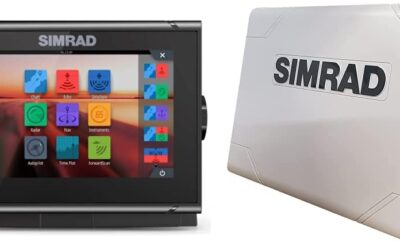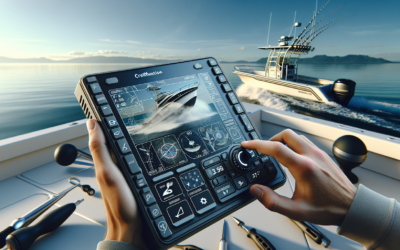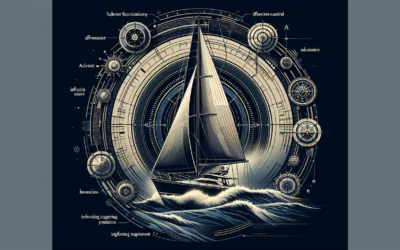So, you’re an angler determined to have a more successful trip? Unleashing the full capacity of your fish finder could be the game-changer you’re searching for. In this insightful article, “The Impact Of Boat Speed: Adjusting Fish Finder Settings On The Move,” you will discover how boat speed affects your fish finder’s performance, and more importantly, how you can adapt your device’s settings while on the go. Empower your fishing experience by learning these essential tips and enjoy a thrilling fishing expedition from now on.
Understanding Boat Speed and Fish Finder Interactions
When it comes to successful fishing, it’s essential to understand the interactions between your boat’s speed and your fish finder’s readings. These interactions play a significant role in ensuring you find and catch the fish you’re after.
Basics of fish finder technology
A fish finder is a type of sonar device that uses sound waves to locate fish underwater. It consists of two parts: a display screen and a transducer. The sonar sound waves are generated by the transducer, which sends them into the water. When these waves hit an object, such as a fish, they bounce back to the transducer, which then translates the data into a visual representation on the display screen.
Understanding sonar waves and readings at different speeds
Your boat’s speed can have a significant impact on your fish finder readings. As your boat moves faster, the sonar waves from your fish finder are compressed, which can change the readings on your display screen. If your boat is moving too fast, it can cause the fish finder to miss fish or give inaccurate readings.
Variables affecting fish finder readings on the move
Several variables can affect your fish finder readings while your boat is moving. These include the speed of your boat, the depth of the water, the temperature of the water, the type of fish you’re trying to locate, and the conditions of the water (such as the presence of seaweed or other underwater objects).
The Role of Boat Speed in Reading Accuracy
Your boat’s speed plays a crucial role in the accuracy of your fish finder readings. Understanding how speed impacts your fish finder can help you make necessary adjustments for accurate readings and better fishing results.
The distortions caused by high speed
When your boat is moving at a high speed, the sonar waves can get distorted, leading to inaccurate or unreliable fish finder readings. This is because the waves can bounce off the water’s surface or other objects in the water, causing them to return to the transducer with false or distorted data.
Finding the optimal speed for accurate readings
To obtain accurate readings from your fish finder, it’s critical to keep your boat at an optimal speed. Typically, a speed of 5-10 miles per hour allows the sonar waves enough time to travel to the water’s depth and back, ensuring accurate readings.
How boat speed influences fish finder detection range
Your boat’s speed also influences the detection range of your fish finder. When you’re moving quickly, the fish finder has less time to detect fish in the boat’s path, decreasing its detection range. On the contrary, a slower speed increases the detection range as the sonar waves have more time to reach a greater area.
Adjusting Fish Finder Settings for Different Boat Speeds
Different boat speeds require different fish finder settings to ensure accurate readings.
Ideal settings for idle and low speed
When your boat is idle or moving slowly, you want your fish finder settings to be on a low ping rate and a high sensitivity to detect fish in a broader range. The slow or stationary movement of the boat allows the sonar waves enough time to travel a farther distance for a comprehensive reading.
Modifying settings for moderate speed
At moderate speeds, the fish finder settings should be adjusted to a higher ping rate and a lower sensitivity. This ensures a good balance between the boat’s speed and the detection of fish.
Optimal high-speed fish finder settings
If you’re moving at high speeds, you’ll want to adjust your fish finder settings to the highest ping rate and the lowest sensitivity. This reduces the chance of distorted readings caused by bouncing waves and ensures that the fish finder detects fish in its immediate path.
Understanding Sensitivity Adjustments Based On Speed
The sensitivity setting on your fish finder plays a significant role in reading accuracy. By understanding how to adjust this setting based on your boat’s speed, you can significantly improve your fish finding success.
Role of sensitivity in fish finder readings
Sensitivity in fish finders determines how much information is picked up by the sonar waves. A high sensitivity setting will pick up smaller objects and details, while a lower setting will only pick up larger objects.
Sensitivity adjustments at different boat speeds
To balance accuracy and noise in your fish finder readings, sensitivity must be adjusted according to your boat’s speed. A lower sensitivity is advisable at high speeds to decrease noise and avoid false readings, while higher sensitivity is suitable for low to medium speeds to detect subtle movements and smaller fish.
Balancing sensitivity and noise
Too much sensitivity can result in a lot of noise, making readings difficult to interpret. Some fish finders have automatic sensitivity adjustments, but manually controlling the sensitivity can still aid you in achieving optimal results.
Controlling Fish Finder Frequency for Speed Adjustments
Another critical aspect of adjusting your fish finder settings to accommodate different boat speeds is controlling the device’s frequency.
Frequency basics in fish finders
In fish finders, frequency refers to the number of sonar waves sent per second. Higher frequencies translate to more detailed readings but shorter ranges, whereas lower frequencies offer less detail but cover longer ranges.
Choosing the right frequency at various speeds
The right frequency can vary substantially depending on your boat’s speed. When you’re moving slowly or are stationary, a higher frequency can be used as the fish finder has more time to collect detailed data. Conversely, when moving at higher speeds, a lower frequency can help in covering a broader detection range.
Adjusting frequency for depth and target size
Frequency can also be adjusted depending on the depth and the size of the fish you’re targeting. High frequencies are great for shallow waters and identifying smaller fish, while low frequencies work better in deep waters and locating larger species.
Dealing with Noise and Interference at High Speeds
High boat speeds can create a lot of noise and interference in your fish finder readings. Understanding how to deal with these can drastically improve your fish finder’s effectiveness.
Causes of noise in fish finder readings
Noise in fish finder readings can be caused by various factors, including water turbulence, other electronic devices on the boat, and even the boat’s speed. High speeds can cause more water turbulence and interference, leading to noisy and fragmented readings on your fish finder.
Adjusting fish finder settings to minimize noise
To minimize noise, you can adjust the fish finder’s settings, such as lowering the sensitivity and using a lower frequency. Additionally, you can also make use of the fish finder’s noise rejection feature, if available.
Utilizing noise rejection features
Many modern fish finders come with noise rejection features, which can be especially handy when dealing with noise caused by high boat speeds. Activating these features can help filter out the noise, delivering a much more clear and precise reading.
Importance of Transducer Installation and Alignment
One of the most critical, yet often overlooked, aspects affecting the accuracy of fish finder readings is the installation and alignment of the transducer.
Impact of transducer placement on reading accuracy
The placement of the transducer can significantly impact the accuracy of your fish finder readings. It is typically installed on the boat’s hull and must be placed where it can continuously make contact with the water without obstruction.
Adjusting transducer alignment for different speeds
For more accurate readings, the transducer alignment can be adjusted depending on the boat’s speed. At higher speeds, the transducer can be angled slightly downwards, while at lower speeds, a straight-down alignment could suffice.
Tips for optimal transducer installation
For optimal transducer installation, ensure that it’s installed where it won’t be disturbed by water turbulence or other obstructions. It should also be aligned towards the stern to ensure the sonar signal effectively covers the area under and behind the boat.
Using Fish Finder Zoom and Bottom Lock Features
Most modern fish finders come equipped with zoom and bottom lock features, which can be incredibly useful at different boat speeds to deliver more accurate readings.
Utilizing zoom features at high speed
Zoom features can come in handy when running at high speeds. This feature allows you to magnify a particular area of the display for a closer look, especially useful in detecting fish that might be close to the surface.
Activating bottom lock for precise readings
The bottom lock feature allows you to focus on a specific depth range, especially useful when moving at higher speeds to get consistent readings. By locking the display to a fixed depth range, the fish finder can provide more accurate and less fluctuating results.
Balancing zoom and lock features with boat speed
Using these features effectively requires an understanding of your boat’s speed. High speeds require more use of the zoom feature, while the bottom lock feature can be used more effectively at lower speeds.
Enhancing the Fish ID feature at Different Speeds
The Fish ID feature further helps in optimizing your fish finder’s performance at various boat speeds.
Understanding the fish ID feature
Fish ID is a feature on some fish finders that helps convert raw sonar returns into fish icons. It provides a simple way of spotting fish without needing to interpret sonar images.
Adjusting fish ID settings at various speeds
You can adjust the fish ID feature to suit the speed of your boat. At high speeds, opt for a quick response setting. This keeps the screen updated promptly despite the quick movement. Meanwhile, at lower speeds, a standard or slow response setting would suffice.
Improving fish ID accuracy at high speeds
To improve the Fish ID accuracy at high speeds, consider reducing the sensitivity and increasing the speed threshold. This reduces the risk of false readings, ensuring the fish icons displayed on your screen are indeed fish.
Case Studies and Practical Applications
Case study: Adjusting fish finder in freshwater at high speeds
In a freshwater environment, such as a lake or river, adjusting your fish finder settings for high speeds can be challenging because of variables like water depth and temperature. However, by lowering the sensitivity and frequency and utilizing features like the zoom and bottom lock, you can still get accurate fish finder readings even at high speeds.
Case study: Fish finder adjustments in marine environments
In a marine environment like the ocean, adjusting your fish finder at high speeds often involves dealing with greater depths and larger fish species. In these instances, using a low frequency, reducing the sensitivity, and ensuring proper transducer placement and alignment are crucial steps to achieving accurate readings.
Practical tips for adjusting fish finder settings on the move
Remember, no matter the environment or the speed of your boat, adjusting your fish finder settings requires experimentation and patience. Always start with lower sensitivity and gradually increase it, adjust the frequency based on the depth and size of the fish you’re targeting, and don’t forget to make use of your fish finder’s features like Fish ID, zoom, and bottom lock. By mastering these adjustments, you can ensure your fish finder delivers the best possible performance under all circumstances.









